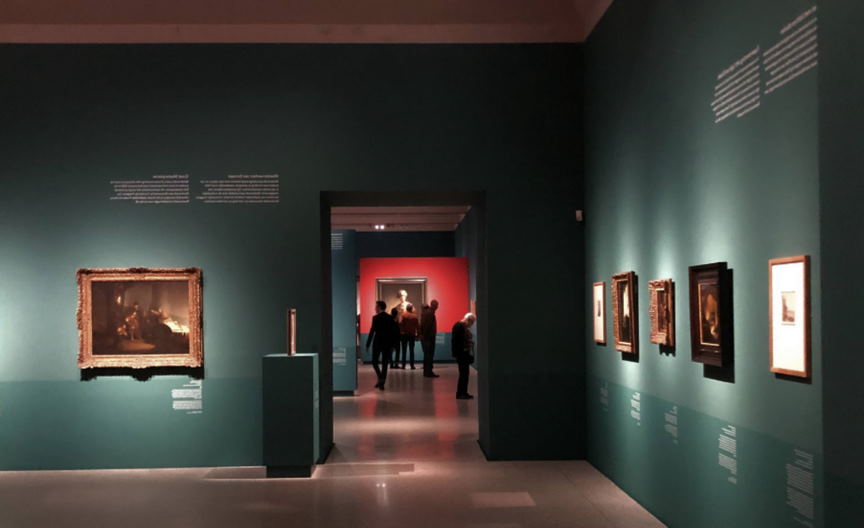Art exhibitions have a unique charm and atmosphere that enables visitors to feel connected with an artist’s work. But in today’s highly competitive art world, artists need to think beyond conventional exhibition formats and create experiences and events that will make their works stand out from the crowd. In this blog post, we’ll explore some creative ways of displaying artwork at your exhibition so you can make sure you draw attention to your artwork and your message. By looking at different angles of exhibiting visual arts like sound, light, space, or multimedia installations, you will be inspired by various compelling art exhibition formats!

Art exhibition formats that will help you showcase your work
- Solo Exhibition – A solo exhibition is a great way to showcase the work of one particular artist or body of artwork in its entirety. This type of exhibition allows for a more comprehensive exploration of your work and offers viewers a unique experience.
- Group Exhibition – A group exhibition brings together multiple artists to explore common themes and ideas in each other’s work. It also allows viewers to compare approaches to similar topics and gain insights from seeing different perspectives on display.
- Interdisciplinary Exhibition – An interdisciplinary exhibition combines art with other creative disciplines such as science, literature, music, theatre, etc., giving viewers a unique experience that incorporates multiple art forms into one space.
- Installation Exhibition – An exhibition featuring installation art that uses various materials and objects to create an immersive experience for viewers. This type of exhibition often requires extensive planning and coordination but can be incredibly powerful when done correctly.
- Outdoor Exhibition – An outdoor exhibition allows you to showcase your work in a natural setting, providing more creativity and experimentation freedom than traditional indoor galleries or spaces. It also offers the opportunity to reach larger audiences who may not typically attend art shows or exhibitions.
- Digital Exhibition – With technology advancing at an ever-faster pace, digital exhibitions are becoming increasingly popular for showcasing artwork without having to bear the costs of printing and displaying physical pieces. Digital exhibitions allow you to showcase your work online and share it with a global audience.
- Pop-Up Exhibition – A pop-up exhibition is a great way to create a buzz around your work, as they often feature many artists at once in one space for a limited period. These exhibitions are usually quick to set up and relatively inexpensive but can still provide an impactful platform for showcasing your artwork.
- Art Fair – An art fair is a great way for artists to showcase their work and gain exposure by participating in larger events that bring together different galleries, art dealers, curators, collectors, critics, and other art professionals from all over the world. This type of exhibition allows you to be seen by potential buyers and establish professional relationships with other art professionals.
- Museum Exhibition – Museum exhibitions are often curated with a specific theme in mind and can provide an invaluable platform for artists to showcase their work. They also offer the opportunity to be seen by larger audiences and gain recognition from the museum’s reputation.
- Virtual Reality Exhibition – Virtual reality (VR) is becoming increasingly popular in the art world, as it allows viewers to explore the artwork in new ways that were not previously imaginable. This type of exhibition provides visitors an interactive experience that can be shared with others without having to leave home or travel elsewhere to attend an event.
How to choose art exhibition formats
There are a few key considerations when considering how to choose an art exhibition format.
First, consider the available space and venue for your exhibition. Will it be in a gallery or museum? Or will it take place outdoors or in a public space? This will help determine what kind of scale and scope you’ll need to keep in mind when deciding on an art exhibition format.
Second, think about the theme or message of your exhibit. Are you trying to convey something specific about your artwork? How can the display design highlight this message? Again, the right format can help create an impactful impression upon viewers.
Third, consider the amount of time you have before and during the exhibition. Do you need to accommodate viewing times or other restrictions? Depending on the format, some setups may require more time and resources than others.
Finally, think about how much audience interaction you want. Is this an interactive exhibition that encourages viewer participation? Or is it a show where viewers wander around quietly observing the art? This will help you decide what kind of format to choose for your exhibition.
By considering these key factors when deciding on an art exhibition format, you can create an amazing experience for your viewers and ensure that your artwork is displayed in its best light.

